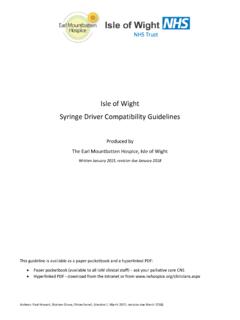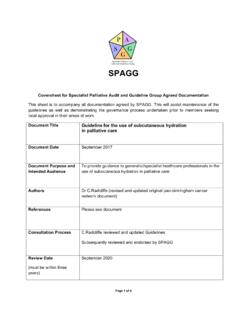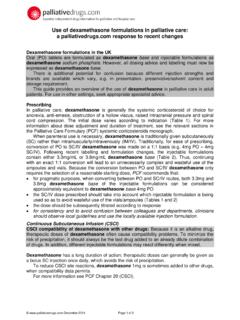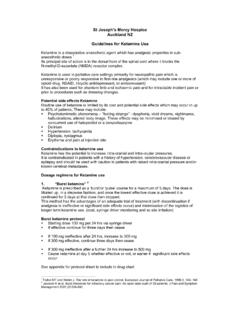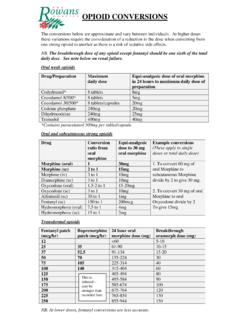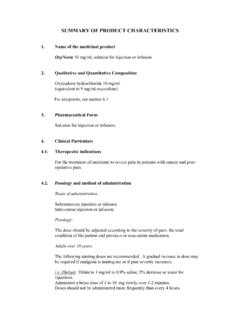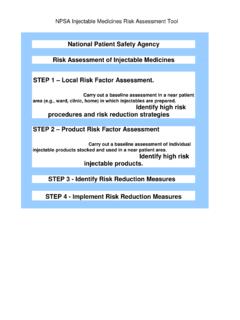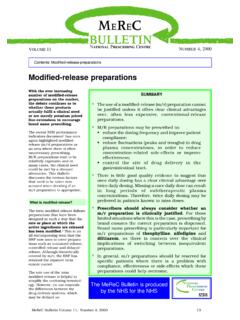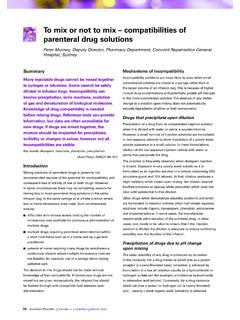Transcription of Anticipatory drugs and syringe driver chart V2
1 In hoursOut of hoursDiscontinue prescriptions by clearly crossing through the whole prescription, with the date discontinued & signature. Do not alter an existing prescription always rewrite a new syringe driver prescription in a new boxThere is space for 4 syringe driver prescriptions Always check for for prescribersCancel drugs Opioids Use 20mL syringes or 30mL if larger volume required. syringes Information for nursesSt Leonard s HospicecYork Teaching Hospital NHS Foundation Trust. Owner: Dr Anne Garry.
2 Issue Date: November 2015. Review Date: November 2018 Version: 2 Approved by: drug and Therapeutic Committee Order number: FY03000081 website for algorithms and conversion charts Services/GP hub or Services/ palliative care Use clear adhesive dressing over the infusion site Patients with syringe drivers should be checked every 4 hours in institutions and as a minimum every 24 hours in a patient's home. If the patient requires additional medication (analgesic/ sedative/antiemetic etc) give a subcutaneous dose of the appropriate drug , as prescribed on the prn section of the drug chart .
3 If ineffective seek medical advice. NB each non-opioid drug has a 24 hour maximum. If you are giving opioids ( , oxycodone, alfentanil) to a patient who has not had one before (opioid na ve), or to a patient who has had a dose increase observe for signs of: Drowsiness Confusion/hallucinations Nausea / vomiting Reduced respiratory rate Twitching Observe patients closely and report any symptoms you are concerned about to the doctor. The opioid may need to be discontinued, reduced or changed to a different opioid.
4 In exceptional cases naloxone may be required to reverse opioid side effects. Refer to naloxone infusion GFR<15mL/min and unable to tolerate oxycodone usealfentanil (500microgram/mL) Look at information in red on: Anticipatory drugs section use oxycodone or alfentanil as sc opioid of choice Prescriptions for opioids & CDs must be prescribed in words and figures. CDs now include midazolam & phenobarbitone Write in whole numbers and where possible avoid decimals. Document dose calculations in the medical notes.
5 The prn dose ranges should reflect the total amount of regular opioid the patient is receiving from all routes (ie syringe driver and fentanyl or buprenophine patch if in situ). The prn dose is one sixth of the 24 hour dose of regular opioids if patient can tolerate the increased opioid dose requirements for the next syringe driver based on the number of additional prn doses over the previous 24 hours (ensuring the pain is opioid sensitive) Remember to prescribe regular medications (including opioid patches) and prn medications (when required) on the chart .
6 Generally use water for injection. Never use sodium chloride with cyclizine as it will crystalliseUse sodium chloride for Levomepromazine by itself syringe driver combinations containing octreotide, methadone, ketorolac, ketamine or furosemidePrescribe approved name of drug entered in CAPITALSD iluents Resources for informationFor patients with renal failure Pleaseif uncertain about drug compatibilities seek advice Specialist palliative care / hospice Medicines information The syringe driver .
7 Continuous subcutaneous infusions in palliative care 3rd edition Andrew Dickman, Jenny SchneiderFor dying patients refer to care plan for last days of life documentation For all other information consult If more information is required please seek help from specialist palliative care Page 12 Page 1 This chart is intended for use in all care settingsOpioid dose conversion chart , syringe driver doses, rescue/prn doses and opioid patchesUse the conversion chart to work out the equivalent doses of different opioid drugs by different formula to work out the dose is under each drug name.
8 Examples are given as a guideFentanyl and buprenorphine patches in the dying/moribund patient Continue fentanyl and buprenorphine patches in these Remember to change the patch(es) as occasionally this is forgotten!o Fentanyl patches are more potent than you may thinkIf pain occurs whilst patch in situ Prescribe 4 hourly prn doses of subcutaneous(sc) morphine unless contraindicated. Use an alternative sc opioid or in patients withalfentanil oxycodoneo poor renal function, o morphine intolerance o where morphine is contraindicated Consult when prescribing 4 hourly prn subcutaneous opioidspink tableAdding a syringe driver (SD) to a fentanyl or buprenorphine patchIf 2 or more rescue/ prn doses are needed in 24 hours, start a syringe driver with appropriate opioid and continue patch(es).
9 The opioid dose in the SD should equal the total prn doses given in the previous 24 hours up to a maximum of 50% of the existing regular opioid dose. Providing the pain is opioid sensitive continue to give prn sc opioid dose & review SD dose daily. Patient on 50 micrograms/hour fentanyl patch, unable to take prn oral opioid and in last days of life. Keep patch on. Use appropriate opioid for situation or care setting. If 2 extra doses of 15 mg sc morphine are required over the previous 24 hours, the initial syringe driver prescription will be morphine 30mg/24 hour.
10 Remember to look at the dose of the patch and the dose in the syringe driver to work out the new opioid breakthrough dose each time a change is made. Always use the chart above to help calculate the correct of breakthrough/ rescue / prn dosesOral prn doses:th Morphine or Oxycodone: 1/6 of 24 hour oral doseSubcutaneous: th Morphine & Oxycodone: 1/6 of 24 hour sc syringe driver (SD) doseth Alfentanil: 1/6 of 24 hour sc SD doseo Short action of up to 2 hourso Seek help If reach Maximum of 6 prn doses in 24 hours (For ease of administration, opioid doses over 10mg, prescribe to nearest 5mg)Renal failure/impairment GFR<30mL/min.

